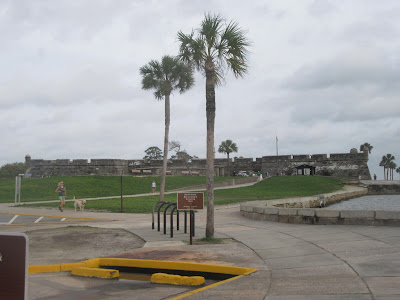St. Augustine Municipal Marina in St. Augustine, FL
THE FIRST COAST
Day #290: Up at 6:45 A.M. for coffee, grapefruit, cookies and mini blueberry muffins. At 9:00 A.M. Mike and I walked to Castillo de Sa Marcos Fort in which construction by The Spanish began in 1672 and took 23 long years to complete. Makes the fort the oldest masonry structure in the United States. At 10:15 A.M. a tornado watch was issued for St. Augustine. Mike bought a few books in the fort gift shop. The two of us walked back to the boat dropping off their purchases. We then headed to the St. Augustine Pirate & Treasure Museum. Mike was able to find another book in the gift shop. I suggested the Burger Bucket for lunch at 11:15 A.M. which had the weather on displayed on the TV the line of storms were moving through central Florida. The two of us ate our burgers quickly so that we could get back to the boat. Once back onboard we put out extra bumpers ready to wait out the storm on the boat. At 1:30 P.M. Severe Thunderstorm Warning was issued for St. Augustine. At 1:34 P.M. the winds picked up, rain started to fall and temperatures started to fall. In 15 minutes the temperature dropped 10 degrees. The weather in St. Augustine ended up being less severe than predicated. "Parrot Bay" survived. At 4:40 P.M. the temperature is 68 degrees after getting to a high of 85 degrees. Mike did some research on marinas when "Parrot Bay" leaves Savannah, Georgia and he read some of his new books. I worked on the blog as I have taken lots of photos in the last few days.
For you history buffs here is the history of Castillo de Sa Marcos Fort:
A Coat of Arms at Castillo de San Marcos.
The boat basin at the east end of the Plaza was constructed as part of the new coquina seawall of 1840. The Basin was important for those who depended on the river and harbor for their livelihood, travel and recreation.
For you history buffs here is the history of Castillo de Sa Marcos Fort:
1513: "Juan Ponce de Leon lands and claims all of North America for Spain, calling it La Florida."
1564: "Phillip II, seeking to protect his claim, sends troops to Florida to expel French invaders and establish outposts to protect Spanish shipping."
1600: "Guale, Timucua, and Apalache Indians are utilized by the Spanish to establish their hold in La Florida. They serve as scouts and laborers."
1670: "Nine wooden forts fail to protect St. Augustine and Spanish ships from attack. The Spanish Crown authorizes a stone fortification."
1738: "Castillo's defenses are strengthened. The walls are raised to 35 feet creating larger and stronger interior rooms. "
1764: "Spain cedes Florida to Great Britain after the French and Indian War. Britain divides Florida into East and West, to better govern their new territory."
1784: "Allied with a victorious United States, Spain regains Florida by the Treaty of Paris that ends the American Revolution."
1812: "American's living in Georgia and Spanish Florida plot to add the territory to the United States. These "self-styled "Patriots" state a revolt, capture Fernandina, and march Ton St. Augustine. The rebellion collapses when Seminoles join forces with the Spanish authorities."
1821: "Spain signs the Adams-Onis Treaty. Florida becomes American territory. U.S. troops rename this structure Fort Marion, a hero of the Revolution."
1861-1865: "Confederates seize and hold Fort Marion from just over a year. Federal warships arrive in March 1862. Union forces garrison St. Augustine for the rest of the American Civil War."
1870-1900: "The first railroad arrives. Tycoon Henry Flagler rebuilds most of St. Augustine. Victorian-era tourism booms and all want to see the old Spanish fort. The Army decommissions Fort Marion in 1900.
1924: "President "Calvin Coolridge signs a law to make Fort Marion a national monument. Congress restores the name Castillo de San Marcos in 1942."
 |
| Fellow looper boat "Heartbeat" on a mooring ball on the north side of the Bridge of Lions. |
 |
| Mike and I heading to visit Castillo de San Marcos National Monument. |
 |
| Looking at the whole fort. |
 |
| Just beyond the fort is the Atlantic Intercostal Waterway looking out to the Atlantic Ocean. |
 |
| Town jail. |
 |
| Carving believed to have been carved by Spanish soldiers. They would have seen British ships often in battle. |
 |
| Look out tower (Garita) |
 |
| The east curtain facing the water. |
 |
| Canons |
 |
| Mortar |
 |
| Mortar |
 |
| Chapel |
 |
| British Rooms |
 |
| Storage Rooms |
 |
| Line of cannons down in the mote. . |
 |
| Mote: the Spanish kept the moat dry and during sieges used it as a pen for domestic animals. |
 |
| Ponce De Leon |
 |
| Remnant of Rodriguez Arsian House. |
 |
| Mike picked to go to the St. Augustine Pirate & Treasure Museum. |
| A cool coffee shop in St. Augustine. |
 |
| Well Mike doesn't have to worry about scurvy!!! |
 |
| My favorite "Time Flies When You're Having Rum!" |
 |
| Rogues Tavern. |
 |
| Display labeled "Main Deck". |
 |
| Execution Dock. |
 |
| Lots of restaurants and shops in St. Augustine. |
 |
| At the Burger Bucket this is written on the wall. |
 |
| My Burger Bucket. |








